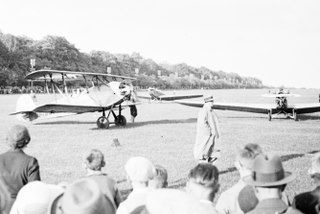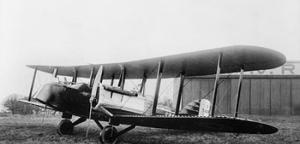
The Tupolev Tu-114 Rossiya is a retired large turboprop-powered long-range airliner designed by the Tupolev design bureau and built in the Soviet Union from May 1955. The aircraft was the largest and fastest passenger plane at that time and also had the longest range, at 10,900 km (6,800 mi). It has held the official title of fastest propeller-driven aircraft since 1960.

The Fairey Barracuda was a British carrier-borne torpedo and dive bomber designed by Fairey Aviation. It was the first aircraft of this type operated by the Royal Navy's Fleet Air Arm (FAA) to be fabricated entirely from metal.

The Supermarine Southampton was a flying boat of the interwar period designed and produced by the British aircraft manufacturer Supermarine. It was one of the most successful flying boats of the era.

The Albatros L 72 was a German transport aircraft of the 1920s, designed to carry newspapers between German cities for Ullstein Verlag. A single revised example was built for the Hamburger Fremdenblatt.

The Viking Dragonfly is an American amateur-built aircraft, designed by Bob Walters and produced by Viking Aircraft LLC of Elkhorn, Wisconsin. The aircraft is supplied as a kit or as plans for amateur construction.
The Miller Lil' Rascal was a two-seat sporting biplane built by high school students in Claxton, Evans County, Georgia, USA, in the late 1970s. Construction began in November 1975 by a group of 15 students at Claxton High School under the direction of B. G. Tippins. Of conventional biplane configuration, it accommodated pilot and passenger side-by-side in an open cockpit. The wings were of dacron-covered wood, and the fuselage was of dacron-covered welded steel tube construction. It had fixed tailwheel undercarriage with spatted mainwheels.

The BAT F.K.26 was a British single-engined four-passenger biplane transport aircraft produced by British Aerial Transport Company Limited of London at the end of World War I.
The Birdman TL-1 was an extremely minimalist aircraft sold in kit form in the United States in the mid-1970s for US$1,395.

The Christen Eagle, which later became the Aviat Eagle in the mid-1990s, is an aerobatic sporting biplane aircraft that has been produced in the United States since the late 1970s.

The Cierva C.8 was an experimental autogyro built by Juan de la Cierva in England in 1926 in association with Avro. Like Cierva's earlier autogyros, the C.8s were based on existing fixed-wing aircraft fuselages – in this case, the Avro 552.

The Reid Rambler, later known under the Curtiss-Reid brand after Reid was purchased by Curtiss, was a biplane trainer/sport aircraft built in Canada in the early 1930s and used in small numbers as a trainer aircraft by the Royal Canadian Air Force.
The Flight Dynamics Flightsail VII was a recreational aircraft marketed in the United States in the 1970s for homebuilding by Flight Dynamics, Inc., most unusual both in its design and its method of construction. The Flightsail VII was intended to be built in three stages, with each stage representing a flyable aircraft of increasing complexity, capability, and cost. It was hoped that this approach would appeal to homebuilders by minimizing the amount of time and money required to take the aircraft to a point where it could be flown.

The Focke-Wulf S 24 Kiebitz was a sport aircraft built in Germany in the later 1920s. It was a single-bay biplane of conventional design with equal-span, unstaggered wings, braced with N-type interplane struts. The pilot and a single passenger sat in tandem open cockpits, and it was fitted with a fixed tailskid undercarriage. The wings could be folded for transportation or storage, and the aircraft was designed to be towed by a car.

The Ganzavia GAK-22 Dino was an unusual light utility aircraft built in Hungary in the early 1990s. In configuration, it was a biplane with cantilever wings and a very pronounced negative stagger, making it almost a tandem wing design. The pilot and a single passenger sat side by side under an expansive bubble canopy, and it had a fixed tricycle undercarriage. The fuselage was of welded steel tube construction, and the wings of duralumin, with the whole aircraft skinned in fabric, other than the forward fuselage which had aluminium skin. A single prototype flew in 1993, but the project was abandoned by the mid-1990s, with the aircraft itself placed in the Transport Museum of Budapest.
The Javelin Wichawk is a sporting biplane designed in the United States in the early 1970s and marketed in plan form for amateur construction.

The Avro 533 Manchester was a First World War-era twin-engine biplane photo-reconnaissance and bomber aircraft designed and manufactured by Avro.

The Kalinin K-4 was an airliner built in the Soviet Union in the late 1920s which was also adapted for use as a photographic survey aircraft and as an air ambulance. A further development of the K-1, it was a conventional high-wing, strut-braced monoplane with separate enclosed cabin and cockpit. Kalinin undertook the design to offer a locally produced alternative to pioneering Ukrainian airline Ukrvozdukhput, which was at that time flying Dornier designs. The structure was of mixed wood and metal construction, but with major assemblies designed in both wood and metal versions, allowing them to be interchanged. The design also featured a variable-incidence horizontal stabiliser, and the engine mounting was intended to facilitate the ready interchange of different powerplants.
The Verilite Model 100 Sunbird was a low-cost light aircraft developed in the United States in the 1980s. It was developed by De Vore Aviation, a company that manufactures aircraft components, as a first foray into aircraft manufacturing. When initiated in 1983, the goal of the project was to create a two-seat light aircraft that could be sold for less than $US 20,000. Additionally, it was hoped that the Sunbird operating costs would be half that of a conventional two-seat aircraft. Funding for the project became available in 1985, and the Verilite subsidiary was created to develop the concept. The design was unconventional: a high-wing, strut-braced monoplane with the single engine fitted in pusher configuration at the rear of the wing, and the empennage carried on an aluminum boom. The pilot and a single passenger sat side by side in a fully enclosed cockpit, and fixed, tricycle undercarriage was fitted. Originally simply dubbed the "Affordable Airplane", the name "Sundancer" was chosen as the winner of a public competition, and later changed to "Sunbird".
The Pottier P.100 and its derivatives were a family of single-engine aircraft developed in France in the 1970s and 80s. They were high-wing cantilever monoplanes of conventional design with enclosed cabins and fixed tricycle undercarriage. The P.100 had two seats, arranged side-by-side, while the P.110 had its fuselage stretched by 50 cm (20 in) to include a third seat and a greater wingspan. The P.105 was a hybrid of the two designs, featuring the shorter, two-seat fuselage of the P.100 and the longer-span wings of the P.110.

The Caproni Ca.193 was an Italian liaison and air-taxi aircraft that was offered to the Italian Air Force as an instrument flight trainer and to the Navy for liaison. Design work started in 1945 and only the prototype was built. It was the last aircraft the Caproni company designed and built in Milan.














